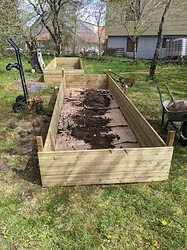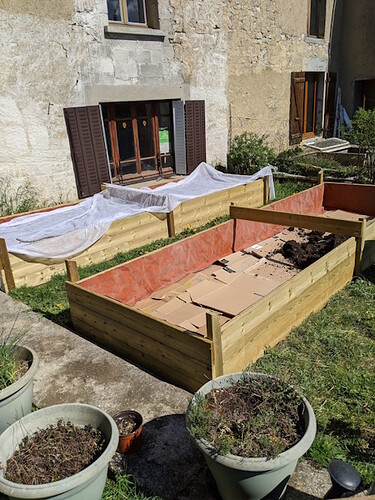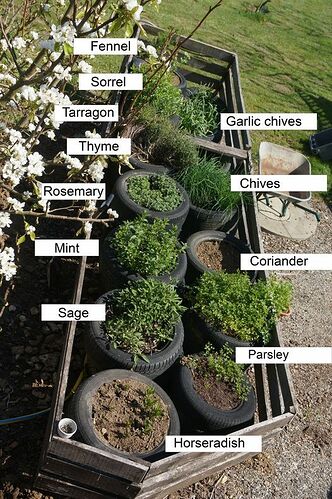Not indoors, I’ll put them on the walls & around the garden
And where do you get your water??
I tried potatoes in buckets because of our vole problem, about 40l bucket per potato and they were miserable. What variety(ies) are you going to try?
I think I might try growing some potatoes in bags next year
We constructed eight raised beds at the start of lockdown. Some in the Orchard, so part sheltered by fruit trees, with a view to future climate changes. The beds facing south against the stone of the house currently get most light and heat by contrast.
I bought treated terrace planks as per the picture. There was no wastage or offcuts.
The base of each was plain packaging cardboard. We have had no problems since with weeds coming up from below, although installed over roots of plum trees.
The posts at the corners are raised to allow to fix another plank in height, the top cross planks are to stop the sides from bowing under the pressure of the filled soil. I do eventually plan to project out a horizontal plank all round, to form a more comfortable seat, or kneeler. Because the planks are treated I used stainless steel screws, and stapled plastic DPM sheet inside the walls to stop the treatment chemicals affecting the soil. I hope by the time they have been there a few years the chemicals will no longer be a problem, although I would be interested to know what others think?
For fill we tried the Hügelkultur approach, and made a quite thick base layer of old logs and branches, since they are quite deep, and I did not want to have to find so much soil to fill them up. eg Hügelkultur Gardening | EcoFarming Daily
Unwisely we acquired a tractor load of apparent top soil scraped off a field by a neighbour farmer. This turned out to be riddled with stones, and very claggy. It did not flourish quite as hoped in 2020.
So we later bought big bags of vermiculite (for water retention - Vermiculite vrac TERRALBA big bag 1000L on ebay.fr ) and big bags of proper certified organic compost (Compost produit à partir de déchets verts par RACINE près de Lyon) This was all loosely influenced by Mel’s mix. cf The Science of Mel's Mix soil
Other considerations are I think: to keep at least a lawnmower width between the beds (because I plan a projecting seating plank more width is needed); to consider how far across the person with the shortest arms can reach, and make that half the width of the raised bed.
We also constructed raised rows. We are using both a no-dig approach as per Charles Dowding (https://charlesdowding.co.uk/) and the square foot gardening approach of mass planting (
History - Square Foot Gardening) along with deep mulch (hemp chivs, but although grown by farmers locally I am still struggling to find that more affordably in big bags.)
Future plans as others have said are a means of trickle feeding water, from the cuves that we have bought, so we do not squander it, if there is a leak (eg Cuve 1000 Litres IBC / GRV - Acheter Cuve plastique 1000 L IBC pehd - cuves 1000 ) . We have had neighbours very kindly water for us when we are away, but they either over water or under water.
Looks like a nice project, but I’d be very wary of the chemicals in the wood. Even though you’ve lined I’d be worried about the gases given off and taken up by the plants. But I’m a fanatic organic gardener .
Water is not a problem for me, I have a 1000l cuve in one of the gardens and just acquired another, have deviated a down pipe from the roof gutter to feed into them. The second garden I water from the citerne in the cellar, the citerne is part of the old village water supply network built before mains water.
So far my potato harvest has been miserable too. This year I have grown Agatha, I’m not impressed, Binje ok but not great, and deseree ok but not impressed either. Doesn’t look like a good year for spuds.
Next year I’ll be growing Binje, Deseree and trial some Russets, all in containers.
When I next go to the Uk I will bring over some Maris Piper’s.
Bringing potatoes from the UK is a huge NO! Potatoes and chrysanthemums are the two most controlled plants.
Have you looked at Stemster? A cross between MarisPiper and Desiree?
I didn’t know that, I will try to source Stemster.
I don’t know if you have box moth in your area, but the French infestation has been traced to a shipment of box plants from China that had moth eggs in them.
Anyway, can’t instantly see who sells Stemster here. But Caesar also makes a good chip
We always grow Charlottes because a) they’re early enough to avoid most of the blight and b) they’re great for the kinds of dishes we most commonly cook. Never tried them in buckets/bins though
I take your point. I was nervous about doing it, but it was the start of lockdown, and the only timber I could readily obtain locally in our rural area. I also did not want to have to reconstruct the bed structures when they rotted. Hence my use of heavy duty DPM. I was equally concerned about some of the recycled plastic based deck boards you can get now, since I think they are just as likely to leach chemicals.
Your comment has made me think about how long raised bed timber frames are likely to last, and whether there is a long term equation using more durable timber to avoid having to reconstruct and replace them.
Your post made me think of more durable untreated timber, since even untreated softwoods rated as highly durable may only last about 10 years at best in a raised bed.
Years ago I specified untreated Greenheart (D70 the highest durability grade for hardwood) for the restoration of the dock timbers and gates in Bridgwater Dock. This was regarded as the most durable timber for this purpose, lasting decades, but difficult to work, and you would be poisoned by splinters. The Canal and River Trust now normally use oak, which is less durable, but still effective. Other organisations suggest: Ekki (also graded D70); Oak (up to D40); and Opepe (D50) for similar partially immersed structures. Purpleheart ( D60) from S America is also used, as are Iroko (D40) and Balau (D50). For similar reasons I recently used iroko for wet room flooring (with non-slip grooves similar to those in decking). Its worked really well in use, warm underfoot, durable, and attractive.
US sources appear to suggest Western Red Cedar for naturally resistant durable raised beds, rated Class 2 (durable), but held to be unsustainable, since it takes 100 years for the tree to grow to form suitable planks, and they last around 10 years in the ground. There is some debate about whether Eastern Red Cedar, seen as invasive, or Juniper (marketed as Red Cedar) would be more sustainable alternatives, with close the same life in a raised bed.
Australian sources suggest another originally US tree, Cupressus macrocarpa Monterey Cypress, for naturally resistant untreated timber raised beds. Its scarcer, but since its grown as an ornamental tree world wide, its at times available.
Thought this may interest some of you.
This is what I’ve sown over the last couple of weeks: spinach after beans, chard between the tomatoes, multi sown beetroot grown in pots and then dotted around the garden where there’s gaps in the beds. Broccoli, kohlrabi and Winter lettuce in pots for planting after I pull my late onion crop and pick the beans to dry, I’ve also sown Spring onions directly after lettuce, I’ll also be sowing Chinese radishes directly this weekend after the last of the French beans.
It’s not too late, to get out in the garden.
This is my solution. Tyres are free, last forever, requires no construction and can be built up bit by bit as required. Each herb has its own soil/watering regime.
In the Burgundy end of Bourgogne Franche Comté! We just ![]() have winter salads…
have winter salads…
They can also leach nasty chemicals into the soil, including some heavy metals if the surface degrades. Using tyres to grow food is really not recommended.
You are absolutely right. I have had this criticism several time over the years. The question no one seems able to answer is “how much?” and how dangerous that amount is. Having researched the subject as much as I can on the 'net there seems to be no real consensus.
What is certain is that when driving a car, the tyres release nano particulants which are 1000 times more polluting than exhaust emissions so as an environment statement I should probably stop driving may car rather than give up growing vegetables in discarded tyres.
But then , if everybody did that, there would be no tyres to grow vegetables in.
From what I understand (my wife having done research in this area years ago), the problems occur when the tyres start to degrade or are chopped up. This accelerates the release of certain compounds used in the manufacture of tyres and also certain heavy metals including mercury. The levels released are very small, but the issue with many of them are that they accumulate in the body and over time can cause increase in cancer risk and neurological damage. I suppose if you’re of a certain age, then the risks are much smaller, but if you’re younger and have children then it would definitely be a no no. One way to minimise the risk is to replace the tyres every 3 or 4 years, or if you detect any degradation of the surface.
As an aside, there was concern years ago at the reuse of tyres to make ‘safe’ surfaces for children’s playgrounds by shredding them and using them to make a bouncy surface. This has now been banned and any tyre waste used in these products has to be treated to remove certain classes of chemicals.
I had our wood (oak and beech) delivered last weekend but it was in 1m lengths so I’m generating a lot of coarse sawdust. Just wondering if there’s any benefit adding some to home made compost before putting it in the planters?
Use it to smoke fish?
Sawdust is great for composing, it needs nitrogen to decompose. I wouldn’t put it directly in the planters as when it starts decomposing it’ll deplete the nitrogen from the soil before putting it back whence fully decomposed. Compost it first.
If you’re new to composting, think lasagna, a layer of green then a layer of
brown.


